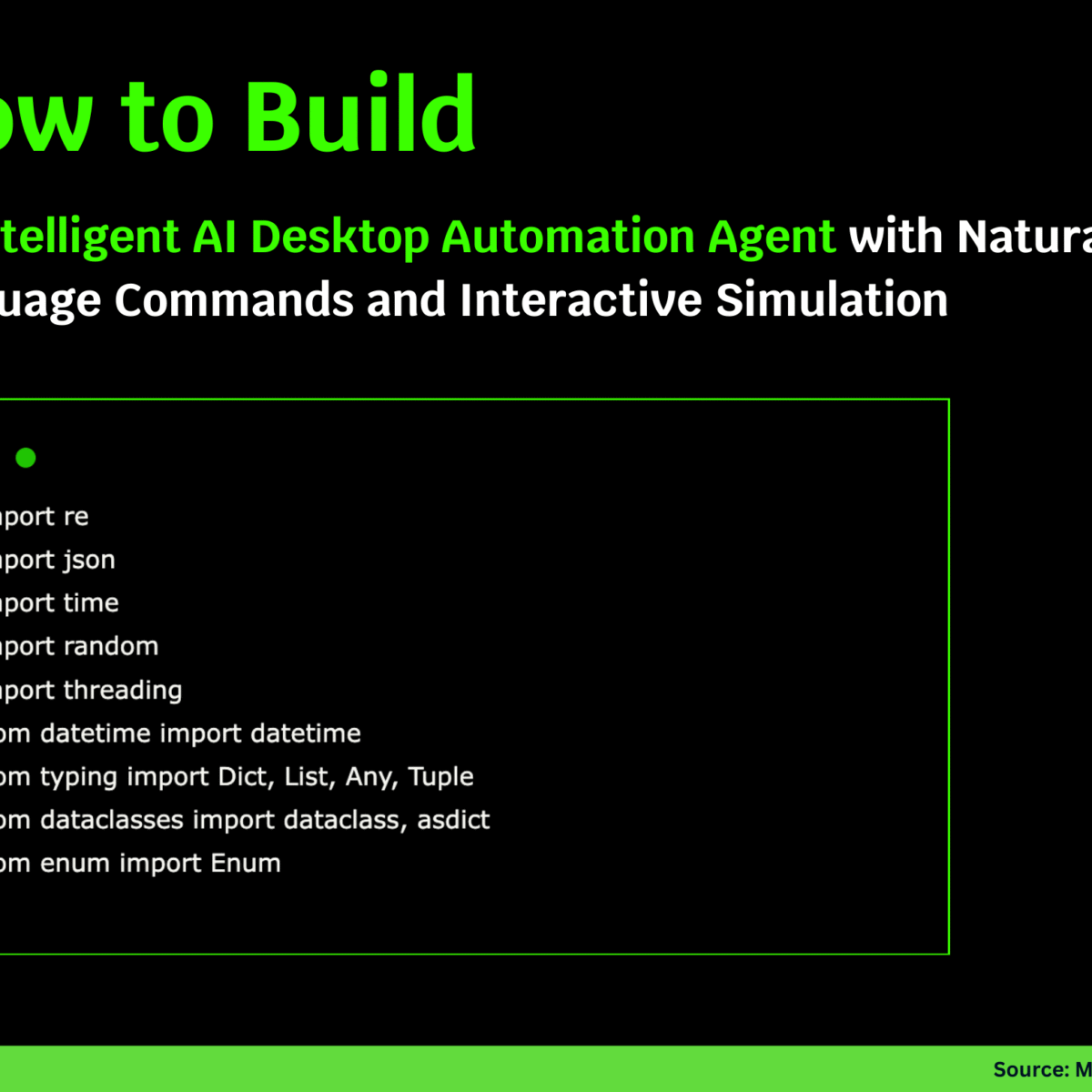Building an Advanced AI Desktop Automation Agent in Google Colab
In today’s tech landscape, the demand for automation and efficiency is at an all-time high. With the rise of artificial intelligence (AI), developers can create innovative solutions to streamline processes usually requiring human intervention. This article guides you through building an advanced AI desktop automation agent that functions smoothly in Google Colab.
Objective of the Project
This AI agent interprets natural language commands to perform desktop tasks such as file operations, browser actions, and workflows. It provides interactive feedback in a virtual environment, offering a user-friendly experience. The goal is to blend Natural Language Processing (NLP), task execution, and a simulated desktop to bring automation concepts to life without requiring external APIs.
Getting Started
To start, open a Google Colab notebook and ensure you have the necessary libraries to facilitate data handling and visualization. The initial setup includes standard modules like re, json, and time, alongside setup configurations specific to Colab.
python
Essential imports
import re
import json
import time
import random
import threading
from datetime import datetime
from typing import Dict, List, Any, Tuple
from dataclasses import dataclass, asdict
from enum import Enum
try:
from IPython.display import display, HTML, clear_output
import matplotlib.pyplot as plt
import numpy as np
COLAB_MODE = True
except ImportError:
COLAB_MODE = False
Designing the Task Structure
To create an organized automation system, we define the types of tasks our agent will manage using an Enum. This categorization simplifies the handling of various commands. The structure includes a Task dataclass for tracking each command’s details, status, and execution results.
python
class TaskType(Enum):
FILE_OPERATION = "file_operation"
BROWSER_ACTION = "browser_action"
SYSTEM_COMMAND = "system_command"
APPLICATION_TASK = "application_task"
WORKFLOW = "workflow"
@dataclass
class Task:
id: str
type: TaskType
command: str
status: str = "pending"
result: str = ""
timestamp: str = ""
execution_time: float = 0.0
Simulating a Virtual Desktop
The core of our automation agent lies in its ability to simulate a desktop environment. This includes essential applications, a file system, and the current system states. A dedicated VirtualDesktop class encapsulates these components, providing functionality for file handling and application management.
python
class VirtualDesktop:
def init(self):
self.applications = {
"browser": {"status": "closed", "tabs": [], "current_url": ""},
"file_manager": {"status": "closed", "current_path": "/home/user"},
More applications…
}
# Define file system structure...Natural Language Processing Engine
The agent’s ability to understand commands hinges on an effective NLP engine. The NLPProcessor class interprets user input, extracting intents and parameters. Regular expressions check against common patterns, training the agent to understand various commands from users accurately.
python
class NLPProcessor:
def init(self):
self.intent_patterns = {
TaskType.FILE_OPERATION: [
r"(open|create|delete|copy|move|find)\s+(file|folder|document)",
More patterns…
],
# Other task types...
}
def extract_intent(self, command: str) -> Tuple[TaskType, float]:
command_lower = command.lower()
# Logic to determine the best task type...Command Execution Engine
With the command parsed, the next step is executing the tasks. The TaskExecutor class handles various task types by implementing methods for file operations, browser actions, system commands, and application tasks.
python
class TaskExecutor:
def init(self, desktop: VirtualDesktop):
self.desktop = desktop
def execute_file_operation(self, params: Dict[str, str], command: str) -> str:
# Logic to simulate file operations...Integration into a Unified Agent
Finally, we integrate the components into a DesktopAgent, which coordinates command processing, task execution, and statistical tracking. This agent leverages the previous classes to ensure smooth operation and provides real-time feedback on task execution.
python
class DesktopAgent:
def init(self):
self.desktop = VirtualDesktop()
self.nlp = NLPProcessor()
self.executor = TaskExecutor(self.desktop)
def process_command(self, command: str) -> Task:
# Handles commands and updates task history...Running the Demo
To visualize the agent in action, we script a demonstration. This includes a series of natural language commands to showcase the agent’s capabilities. The interactive nature allows users to engage directly with the agent, processing custom commands in real time.
python
def run_advanced_demo():
agent = DesktopAgent()
Executing demonstration commands…
Interactive Command Mode
The solution also includes an interactive mode for user input. Users can type natural language commands and receive immediate feedback, allowing for a versatile user experience.
python
def interactive_mode(agent):
while True:
user_input = input("\n🤖 Agent> ").strip()
Command processing logic…
Conclusion
With this implementation, we see how an AI agent can effectively manage various desktop tasks using only Python. By translating natural language inputs into structured tasks, the system executes commands with realistic outputs and summarizes operations in a live dashboard. This foundation paves the way for more complex behaviors and real-world integrations, enhancing desktop automation’s intelligence and usability.
Feel free to dive deeper and explore the complete code in this GitHub repository.





